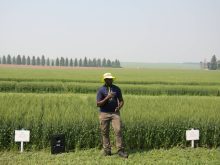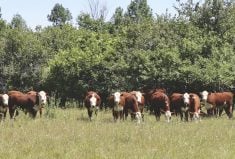They’re also ‘foraging’ for nutrients, deciding where to put their roots, and calling for help when under attack
You might think it’s crazy — but plants talk to each other and act in ways that are similar to animals and humans.
“Step away from the idea of plants as factories and start to think of plants as individuals,” biological sciences professor JC Cahill told attendees at the Western Canadian Soil Health and Grazing Conference.
Most people rely on assumptions that don’t reflect what’s actually happening in their fields or gardens, said the University of Alberta scientist, who works in a new field called evolutionary agro ecology.
Read Also

Moo translator and methane measures: There’s an app for that
Dalhousie University researchers use artificial intelligence to create new dairy farm apps that analyze cattle sounds and measure methane.
Take, for example, the act of applying fertilizers as evenly as possible. Plants don’t just grow roots randomly in the soil, said Cahill. Instead, they respond to where the food is located.
“If you put it everywhere, they will put their roots everywhere. If you put it in one place, they will put their roots almost in one place,” he said.
The bread and butter of Cahill’s work is about ‘foraging,’ and he has studied 100 different plant species to see how they seek out nutrients. What he found is that individual plants make decisions on where to put their roots, and that’s where they can get the most nourishment.
“This is the norm of plants — that they make decisions on root growth if they live in a patchy environment,” he said.
The only homogenous soils in the world are ones that are tilled, so no-till fields and ones utilizing cover crops are more similar to natural environments. If plants find a high-quality patch of nutrients, they will stop extending their root systems.
This has significant implications when it comes to applying fertilizer.
“They’re making these very complicated decisions that you would never measure by just pulling up plants and looking at which roots are there,” he said. “These are about timing, not about the total amount.”
Plants also share another common trait with humans and animals — they have trouble making good decisions when stressed.
In one experiment, Cahill and other researchers spiked soil with white particles and used algorithms to follow soil movement rather than root movement, tracking small movements of rocks within the soil. This allowed them to measure root growth over a matter of hours.
“When we clipped them, they kept growing roots, but for the first 100 hours, their growth was random,” said Cahill.
But around the 120-hour mark, they effectively started behaving rationally again and focused root development on where the biggest concentration of nutrients were.
“This is crazy. This is exactly what you see in human psychology experiments when an external stressor stops rational decision-making,” he said.
This suggests that the reaction of plants might change when stressed, including how much fertilizer they utilize when put down during a stressful time.
Most plants have a shade avoidance response, and get tall and thin in a bid to rise taller than their neighbours. Below ground, plants also compete.
In Cahill’s lab, he chose 20 species and put them in a fight with other plants to see where they grew their roots. Some plants grew roots toward their neighbours, while others grew away. Every plant did something different.
Again, this has implications for farmers.
“If you have two plants of the same species, if they grow their roots to maximize combat, you’re having crop fight crop,” he said. “That’s not good for yield.
“But if they run away from like plants, you’re minimizing the amount of fighting in what you’re going to harvest. That’s good for yield.”
Conversely, when crops are attracted to the roots of other species, that results in weed suppression, he said.
Cahill predicted this sort of research will have a huge impact on farms in 20 years — although scientists will have to know much more about the behaviour of individual plant species before they can make specific recommendations.
Another promising area is family relationships.
And even though plants have no brain, no nervous system and no visual recognition, they can recognize kin. Plants increase their root growth and competition with neighbours when they are unrelated. Plants also protect kin and attack strangers.
“When there’s a stranger — a weed — we want them to fight hard for weed suppression,” said Cahill. “If we can harness this into a new generation of crop by having our breeders focus not just on height and the other things, but focus on the ability to detect kin, that’s huge.”
Fostering this ability in a crop would reduce the need for herbicides while another, equally intriguing area of research, could do the same for insect control.
Plants emit chemicals and researchers, including Cahill’s team, are looking at ones they emit when under attack. These chemical ‘odours’ lure natural predators of the bugs nibbling on their leaves or stems, and can even trigger a similar reaction in neighbouring plants that aren’t yet under attack, effectively warning them that enemies are nearby.
These sorts of behaviour form a plant ‘language’ and now scientists are taking it further. Current research is showing the language that plants are using is heritable, and even that local dialects are passed from parent plants to their offspring. Different families of plants use slightly different language, and individuals respond more to their own dialect.
















